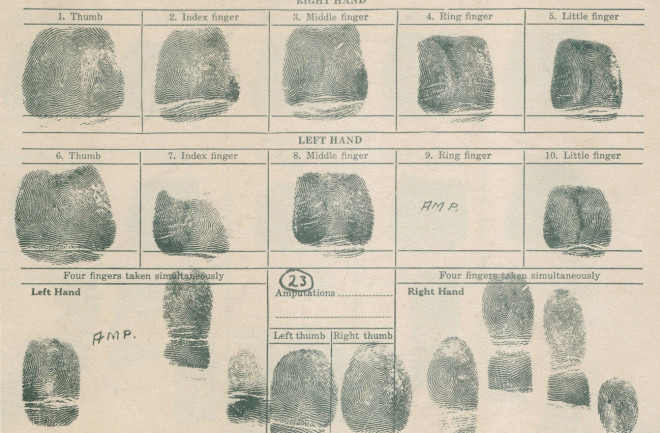In the early morning hours of Sept. 19, 1910, Mary Hiller awoke inside the Chicago home she shared with her husband and four children. The gas light at the head of their stairway, which she always left running overnight, was out — so she sent her husband to investigate.
Upon inspection, Clarence Hiller found an intruder: a recently paroled man named Thomas Jennings. The two struggled briefly before several gunshots rang out, leaving Hiller dead. Prior to this fatal encounter, Jennings had sexually assaulted one of Hiller’s daughters.
Jennings fled, but police detained him less than a mile from the crime scene. He was bloodied, with torn clothing and a recently fired .38 revolver. His explanation for his ragged appearance — of having fallen from a trolley — wasn’t convincing enough for police, who arrested him.
But it wasn’t just this evidence or eyewitness testimony that ultimately sentenced Jennings to death for murder. It was also the fingerprints he left on a freshly painted handrail.
Read More: Top 5 Pieces of Forensic Evidence Used to Solve a Crime
When Did Fingerprinting Start?
Human fingerprinting goes back thousands of years, but the first modern use of it for identification likely originated in colonial India. Around 1860, Sir William James Herschel, a British Indian Civil Service officer, began experimenting with finger- and handprints as a way to sign contracts.
Henry Faulds, a Scottish medical missionary in Japan in the 1870s and 80s, also became fascinated by fingerprints; more specifically, he wondered how they might be applied forensically. His first public musing on it was published in Nature in 1880.
Faulds shared his ideas in writing with Charles Darwin, who in turn passed them to his relative, anthropologist Sir Francis Galton. It was Galton who eventually published three books about such fingerprint concepts, including his 1892 Finger Prints.
Though Galton is also infamously known for his theories on eugenics, he helped create the basic system of fingerprint ridge patterns — called arches, loops and whorls — we still use to uniquely ID someone today.
This system later became the standard for Sir Edward Henry, chief commissioner of London’s Metropolitan Police. After the Galton-Henry system of fingerprint classification was published in 1900, it Scotland Yard officially adopted it in 1901 for criminal records.
Less than a decade later, Jennings left four fingerprints on a recently painted back porch railing outside the Hiller home. Using the railing to hoist himself up, he then entered through the kitchen window.
Read More: Why Do We Have Fingerprints?
When Were Fingerprints First Used As Forensic Evidence?
The morning after the murder, police investigators removed the railing and made enlarged photographs of the prints. They compared those images to two other enlarged fingerprint sets — one from Jennings’ arrest and another taken months earlier, following a parole violation that had sent him back to prison.
By the time of the November 1910 trial, fingerprints already enjoyed wide usage in the U.S. for criminal records and identifying federal prison inmates. But their use in courtrooms, specifically for murder cases, wasn’t nearly as prominent.
During Jennings’ trial, prosecutors used expert testimony from four people skilled in fingerprinting: Michael P. Evans, head of the Chicago Police Department’s Bureau of Investigation; William M. Evans, a former bureau member; Edward Foster, a Canadian police inspector; and Mary Holland, the first female fingerprinting instructor.
The four witnesses had personally studied and made thousands of fingerprint sets, and enlightened the courtroom to the basics of how the system worked. Each expert also confirmed that the multiple print sets in the trial were all left by the defendant.
Other evidence didn’t help his case. Jennings’ statements on his injuries and whereabouts were inconsistent with testimony from other witnesses. Bullets from the crime scene were the same as the ones in his revolver. Even the dirt from his shoes matched the dirt left on the Hiller daughter’s bed.
Fingerprint Analysis: Guilty
On Nov. 10, 1910, a jury delivered a unanimous guilty verdict, with only one person declining a death sentence. By the third ballot, however, this too was unanimous.
Jennings’ lawyers appealed — objecting both to the admissibility of the fingerprints and that fingerprint examiners were considered expert witnesses. The case reached the Illinois Supreme Court in 1911, but there the conviction was upheld: Fingerprinting was a science, and expert testimony on it was deemed acceptable in a trial.
A habeas corpus petition, arguing that police violated Jennings’ rights when they made him provide fingerprints, was denied in a U.S. District Court and on Feb. 16, 1912, Jennings was hanged.
He is considered the first criminal in U.S. history to be convicted based on fingerprint evidence. In the decades that followed, courts sided the ruling in People v. Jennings as a precedent for the inclusion of fingerprint evidence.
And though it has not proved universally sound over the last century, fingerprinting remains an enduring piece of forensic criminal investigation alongside more modern techniques.
Read More: Taking a Closer Look at Forensic Science Behind U.S. Criminal Justice
